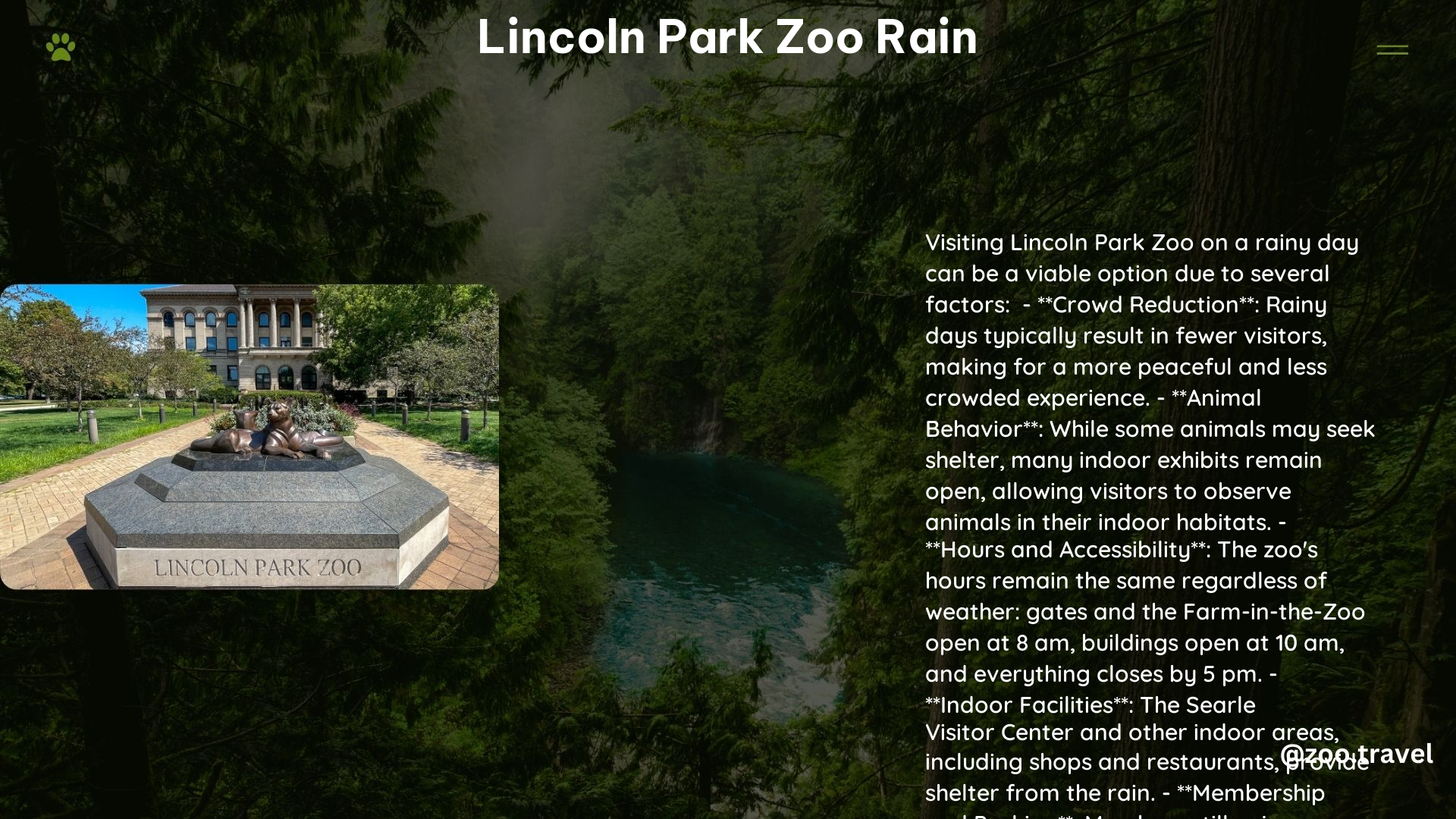Lincoln Park Zoo offers a unique experience even on rainy days. With its free admission policy, indoor exhibits, and special programs, visitors can enjoy the zoo regardless of the weather. The zoo’s indoor habitats are designed to mimic natural environments, ensuring animal comfort and visitor engagement. Rainy days often mean fewer crowds, allowing for a more peaceful exploration of the zoo’s diverse attractions and conservation efforts.
What Indoor Exhibits Are Available During Rain?

When the rain starts falling at Lincoln Park Zoo, visitors can take shelter in several indoor exhibits that offer a dry and comfortable viewing experience:
- Lion House:
- Home to majestic lions
- Warm, dry space for both animals and visitors
-
Educational displays about lion conservation
-
Reptile House:
- Houses various reptiles, amphibians, and insects
- Climate-controlled environment mimicking natural habitats
-
Interactive displays about cold-blooded creatures
-
Penguin Exhibit:
- Indoor-outdoor habitat for African penguins
- Heated deck to prevent icy conditions
-
Underwater viewing area for up-close penguin observations
-
Regenstein Macaque Forest:
- Indoor areas with heated rocks for Japanese macaques
- Fan-cooled sheltered spaces
- Educational panels about macaque behavior and social structures
How Does Rain Affect Zoo Attendance and Experience?

Rain at Lincoln Park Zoo can actually enhance the visitor experience in several ways:
- Reduced Crowds: Rainy days often deter some visitors, resulting in a less crowded zoo environment.
- Peaceful Atmosphere: The sound of rain creates a soothing backdrop for animal viewing.
- Unique Animal Behaviors: Some animals may display different behaviors during rainy weather, offering a rare glimpse into their adaptations.
| Aspect | Rainy Day Impact |
|---|---|
| Crowd Size | Reduced |
| Atmosphere | Peaceful and serene |
| Animal Activity | Potentially increased for some species |
| Indoor Exhibit Focus | Enhanced |
What Special Programs Are Available on Rainy Days?
Lincoln Park Zoo maintains its educational programs and animal care routines even during rainy weather:
- Indoor Animal Training Sessions:
- Observe zookeepers working with animals in covered areas
-
Learn about positive reinforcement techniques
-
Conservation Education Programs:
- Attend indoor presentations about wildlife conservation
-
Participate in interactive displays focused on environmental protection
-
Feeding Demonstrations:
- Watch scheduled indoor animal feedings
-
Learn about animal diets and nutrition
-
Community Care Initiatives:
- Discover how the zoo contributes to local and global conservation efforts
- Engage with staff about volunteer opportunities
How Does the Zoo’s Free Admission Policy Work During Rain?
Lincoln Park Zoo’s commitment to free admission remains steadfast, rain or shine:
- No entrance fee required, regardless of weather conditions
- All indoor exhibits accessible at no cost
- Special programs and demonstrations included in free admission
This policy ensures that visitors can enjoy the zoo’s offerings without financial barriers, making it an ideal rainy day activity for families, students, and animal enthusiasts alike.
What Measures Does the Zoo Take to Ensure Animal Comfort in Rainy Weather?
Lincoln Park Zoo prioritizes animal welfare in all weather conditions, including rain:
- Climate-Controlled Habitats:
- Indoor spaces with regulated temperature and humidity
-
Mimics natural environments of various species
-
Heated Elements:
- Warm rocks and surfaces in exhibits like the Regenstein Macaque Forest
-
Prevents discomfort from cold, wet conditions
-
Sheltered Outdoor Areas:
- Covered spaces in outdoor exhibits
-
Allows animals to choose between indoor and outdoor environments
-
Specialized Care Routines:
- Adjusted feeding schedules if necessary
- Extra enrichment activities during extended periods of rain
How Can Visitors Prepare for a Rainy Day at Lincoln Park Zoo?
To make the most of a rainy day visit to Lincoln Park Zoo, consider the following tips:
- Dress Appropriately:
- Wear waterproof jackets and shoes
-
Bring umbrellas for outdoor transitions between exhibits
-
Plan Indoor Routes:
- Obtain a zoo map to identify covered pathways
-
Focus on indoor exhibits and attractions
-
Check Special Programs:
- Review the daily schedule for indoor presentations
-
Arrive early for popular feeding demonstrations
-
Bring Camera Protection:
- Use waterproof cases for cameras and phones
-
Capture unique rainy day animal behaviors
-
Pack Snacks and Drinks:
- Bring sealed food and beverages
- Enjoy indoor picnic areas if outdoor seating is wet
What Conservation Efforts Are Highlighted During Rainy Days?
Rainy days at Lincoln Park Zoo provide an opportunity to focus on the zoo’s conservation initiatives:
- Species Survival Plans:
- Learn about breeding programs for endangered species
-
Understand the zoo’s role in global conservation efforts
-
Urban Wildlife Institute:
- Discover research on local wildlife adaptation to urban environments
-
Explore how rain affects urban ecosystems
-
Climate Change Education:
- Engage with displays about the impact of changing weather patterns on wildlife
-
Learn about the zoo’s sustainability practices
-
Conservation Ambassador Program:
- Meet with zoo staff to discuss ongoing conservation projects
- Find out how to contribute to wildlife protection efforts
By highlighting these programs, Lincoln Park Zoo ensures that rainy days become opportunities for deeper engagement with conservation issues and animal welfare.
How Does Rain Impact the Zoo’s Landscape and Botanical Areas?
While rain may limit outdoor exploration, it plays a crucial role in maintaining the zoo’s diverse plant life:
- Natural Irrigation:
- Rain provides essential water for the zoo’s trees, shrubs, and flowers
-
Reduces the need for artificial watering systems
-
Pond and Water Feature Maintenance:
- Rainwater helps replenish and refresh water exhibits
-
Supports aquatic ecosystems within the zoo
-
Seasonal Plant Displays:
- Rain encourages growth and blooming of seasonal plants
-
Enhances the zoo’s natural beauty
-
Stormwater Management:
- The zoo’s landscape design includes features to manage rainwater runoff
- Demonstrates eco-friendly urban planning practices
Visitors can learn about these aspects through indoor displays and educational signs throughout the zoo, even on rainy days.
In conclusion, Lincoln Park Zoo offers a rich and engaging experience during rainy weather. From its diverse indoor exhibits to its ongoing conservation programs, the zoo provides visitors with numerous opportunities to connect with wildlife and nature, regardless of the weather conditions. The free admission policy ensures that this educational and entertaining destination remains accessible to all, making it an ideal choice for a rainy day in Chicago.
References:
1. Lincoln Park Zoo – Chill Factors
2. The Artful Attempt – What to Do When It’s Raining in Chicago
3. YouTube – Rainy Day at Lincoln Park Zoo 2022
